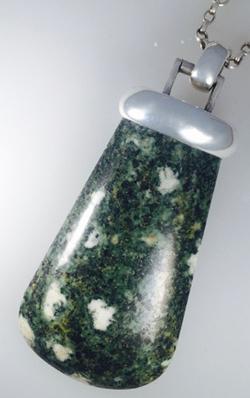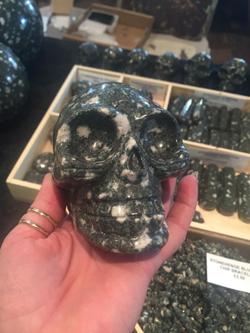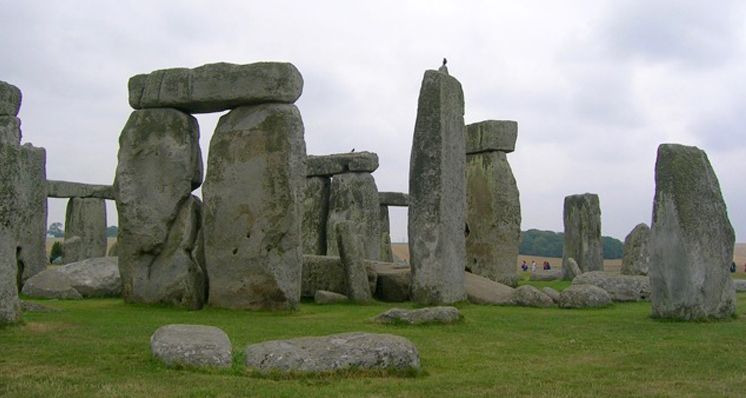Sarah Steele FGA DGA discusses the unusual history of ancient Preseli bluestone.
If ever there was an unlikely candidate for a gem material then Preseli spotted dolerite, would at least at face value, be it. Over the last five or six years however it has appeared on the market in increasing quantities, both as jewellery and ornamental items, prompting English Heritage and the National Trust to consider unprecedented measures in order to restrict its sale, leading to an ethical debate: should this native material, which has been important to the occupants of the British Isles since 2900 BC, be available for our general consumption or removed from the market to protect the suggested source of the raw material?
It seems that the people of the twenty-first century have a desire to own a piece of the material, which has almost come to represent the Stone Age, a material of such importance to our Neolithic ancestors that they engaged in a seemingly impossible feat of human engineering, moving huge blocks of this material 250 miles in order to build one of the world’s most iconic ancient monuments – Stonehenge.


Piece of bluestone.
Stonehenge
Stonehenge, on Salisbury Plain, Wiltshire has been a designated a UNESCO World Heritage Site since 1986, ranking alongside sites such as Machu Picchu in Peru and the Xian Terracotta Warriors in China.
It is a complex site, best known for the standing stones – the collective landscape of which, in association with other surrounding structures, demonstrates Neolithic and Bronze Age ceremonial and mortuary practices resulting from around 2,000 years of continuous use between 3700-1600 BC. The sheer size of its megaliths, the sophistication of its concentric plan and architectural design, the shaping of the stones and the precision with which it was built, secures Stonehenge as one of the most impressive prehistoric megalithic monuments in the world.
The large stones that form the Outer Circle are known as ‘sarsens’. They are hard, resistant sandstones thought to have been collected from glacial moraine deposited within the local Salisbury Plain environment. The sources of the smaller stones that form the Inner Circle and the Inner Horseshoe, known as the ‘bluestones’, are not native to the Salisbury Plain area.
Read more: Whitby Jet, A Discussion of its Simulants
The earliest structures known in the immediate area are four or five pits, three of which appear to have held large pine totem-pole-like posts erected in the Mesolithic period, between 8500 and 7000 BC. It is not known how these posts relate to the later monument of Stonehenge but we do know that in about 2900 BC the bluestones were set up in the centre of the monument.
Perhaps the distance over which these bluestones have been transported is the cause of man’s fascination with them, instead of the larger sarsen stones. This was addressed in 1923 by H. H. Thomas from the Geological Survey, who published a paper in The Antiquaries Journal claiming that he had “sourced the spotted dolerite component of the bluestones in hilltop rock outcrops in the High Preseli, to the west of Crymych in west Wales. Specifically, he thought that the tors on Carn Meini (also known as Carn Menyn) and Cerrig Marchogion were the likely source outcrops” (Earth Heritage, Summer 2013).
Geology
Preseli bluestone is a metamorphosed dolerite outcropping in the Preseli Hills, known locally as Preseli Mountains, Pembrokeshire Wales. It is particularly notable for its spotted appearance in hand specimen, an effect caused by low-grade regional metamorphism during the Caledonian Orogeny.
In thin sections the rock contains large pyroxene (augite) and altered plagioclase grains. The original igneous minerals have been partially altered to chlorite and epidote during greenschist grade metamorphism, and although large pyroxene grains remain, almost all the plagioclase has been altered. The remainder of the fine-grained matrix was also altered by metamorphism, although many igneous mineral shapes are evident. Not all of the bluestones standing today at Stonehenge, however, are spotted dolerites. Four of them are ash-flow tuffs, of rhyolitic composition.
In order to identify the origin of the bluestones, Aberystwyth University has worked to analyse the composition of micron-sized zircon crystals from rhyolite samples from Stonehenge using Laser Ablation Inductively Coupled Plasma Mass Spectrometry (LA-ICP-MS). The technique focuses a very high-power laser beam onto the zircon crystals to ‘ablate’ them – essentially vaporising them. The vapour generated by this process is then analysed in the mass spectrometer, which reveals the chemistry of the zircon crystals. This was the first time zircon chemistry had ever been used to determine the provenance of archaeological material. New research by a team of scientists including researchers from University College London (UCL), University of Manchester, Bournemouth University, University of Southampton, University of Leicester, Amgueddfa Cymru – National Museum Wales and Dyfed Archaeological Trust, presents detailed evidence of prehistoric quarrying in the Preseli Hills in Pembrokeshire, helping to answer long-standing questions about why, when and how Stonehenge was built.
Read more: Getting to Grips with GemTOF Technology
They have identified the outcrop of Carn Goedog as the main source of Stonehenge’s ‘spotted dolerite’ bluestones and the outcrop of Craig Rhos-y-felin as a source for one of the ‘rhyolite’ bluestones. The special formation of the rock, which forms natural pillars at these outcrops, allowed the prehistoric quarry-workers to detach each megalith with minimal effort. Dr Josh Pollard, from the University of Southampton, said: “They only had to insert wooden wedges into the cracks between the pillars and then let the Welsh rain do the rest by swelling the wood to ease each pillar off the rock face. The quarry-workers then lowered the thin pillars onto platforms of earth and stone, a sort of ‘loading bay’ from where the huge stones could be dragged away along trackways leading out of each quarry.”
Modern Demand
The material which has flooded the market is Preseli spotted dolerite rather than the rhyolitic material. It is fashioned primarily into large cabochons or skulls, spheres, wands and other items evoking pagan symbolisms. The bulk of the material is polished in mainland China, with elaborate carvings being worked in the Netherlands according to my source.


The bodies that are concerned with protecting the sites of the bluestone are increasingly concerned that illegal extraction of material must be occurring due to the large quantity of material on the market. This has an implication from an archaeological point of view as these ancient sites, believed to be the Neolithic quarries from where the megaliths were extracted, may still hold clues as to Stonehenge’s history and are designated Sites of Special Scientific Interest (SSSI) and are therefore legally protected.
Having spoken to the source of the majority of rough material into the supply chain, however, I am assured that all the material currently on the market has come from his source, a farmland some 500 m outside the boundary of the SSSI. He explained to me that the source of his deposits are glacial erratics, the weathering skins of which have indicated a date of deposition circa 11,000 BC at the end of the last ice age and predating quarrying activity by some 7,000 years. The erratics are dug up from his farmland, usually five to six feet below the surface and then exported for manufacture.


Despite this, in order to protect the bluestone quarries, it has been proposed that a worldwide ban of the sale of Preseli spotted dolerite may be required. This would be unprecedented for a non-organic gem material and raises the important question of whether (and, indeed, how) such prehistoric stone sources should be protected and conserved in the future. It also demonstrates the need for geologists, archaeologists and manufacturers to work more closely together to ensure a greater transparency regarding the sourcing of our British gem materials.
Why Preseli Bluestone?
The new discoveries may also help to understand why Stonehenge was built. Professor Parker Pearson and his team believe that the bluestones were erected at Stonehenge around 2900 BC, long before the giant sarsens were put up around 2500 BC. So why did Neolithic man decide to use Preseli bluestone?
A twelfth-century account of Geoffrey of Monmouth uses the myth of Merlin bringing the stones to Stonehenge and states that the stones had medicinal properties that could be accessed by washing the stones and then pouring the water into baths. The water absorbed the healing virtues of the stones. Even today, folklore in Pembrokeshire suggests that the Preseli bluestones possess healing qualities. There is yet another intriguing (and surprising) aspect to the Preseli bluestones, which is that a relatively high proportion of them (perhaps as much as 10%) have the rare property of being lithophones – ‘musical stones’. That is, they can ring like a bell or gong, or resound like a drum, when struck with a small hammerstone, instead of the dull ‘clunking’ sound rock-on-rock usually makes.
Read more: The History of Diamonds in Engagement Rings
As gemmologists we seldom use sound when contemplating gemstones, other than the distinctive ‘chink’ of spodumene perhaps, but as a lapidary, sound is important when polishing stones. We are often subconsciously using sound for facet orientation, to listen for surface imperfections and to distinguish different hardnesses of the material we are polishing.
The fact that lithophones are along the Carn Menyn ridge tends to suggest that sound may indeed have been an important factor in the general location being special to Neolithic people – the sounds from stones were perhaps perceived as emanating from spirit inhabitants of rock and cliff interiors. The underlying reason for the perceived importance or special nature of the bluestones by Neolithic people therefore seems to lie in the idea that Mynydd Preseli was viewed as a sacred land in that era. Could it be that deep within our psyche we still carry a connection with this ancient landscape and the desire for objects made of the bluestones is still strong within us? ■
This article originally appeared in Gems&Jewellery Mar/Apr 2016 / Volume 25 / No. 2 pp. 25-27
Interested in finding out more about gemmology? Sign-up to one of Gem-A’s courses or workshops.
If you would like to subscribe to Gems&Jewellery and The Journal of Gemmology please visit Membership.
Cover image Stonehenge. All images courtesy of Sarah Steele.
{module Blog Articles Widget}



